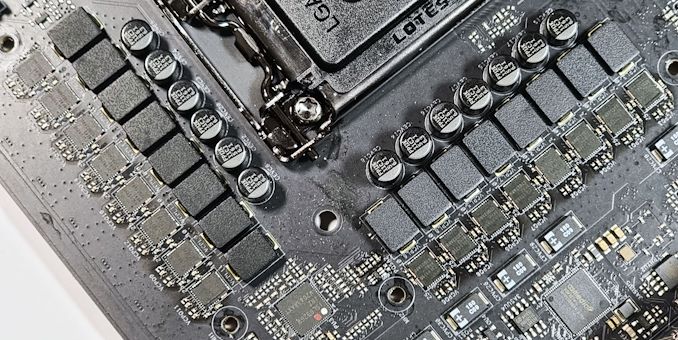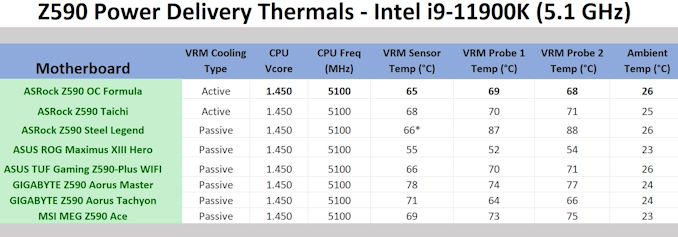The ASRock Z590 OC Formula Review: An Iconic Brand Revival
by Gavin Bonshor on September 10, 2021 9:00 AM ESTPower Delivery Thermal Analysis
Recently, a lot more focus has been put on power delivery specifications and capabilities, not just by manufacturers, but as a result of users' demands. In addition to the extra power benefits from things like overclocking, more efficient designs in power deliveries and cooling solutions aim to bring temperatures down. Although this isn't something most users ever need to worry about, certain enthusiasts are bringing more focus onto each board's power delivery. The more premium models tend to include bigger and higher-grade power deliveries, with bigger and more intricate heatsink designs, with some even providing water blocks, while others are spending more just to make sure the most efficient parts on the market are being used.

The 16-phase power delivery on the ASRock Z590 OC Formula (operating in 8+0 with doublers)
Testing Methodology
Our method of testing is if the power delivery and its heatsink are effective at dissipating heat. We do this by running an intensely heavy CPU workload for a prolonged method of time. We apply an overclock, which is deemed safe and at the maximum that the silicon on our testbed processor allows. We then run the Prime95 with AVX2 enabled under a torture test for an hour at the maximum stable overclock we can, which puts insane pressure on the processor. We collect our data via three different methods which include the following:
- Taking a thermal image from a birds-eye view after an hour with a Flir Pro thermal imaging camera
- Securing two probes on to the rear of the PCB, right underneath CPU VCore section of the power delivery for better parity in case a probe reports a faulty reading
- Taking a reading of the VRM temperature from the sensor reading within the HWInfo monitoring application
The reason for using three different methods is that some sensors can read inaccurate temperatures, which can give very erratic results for users looking to gauge whether an overclock is too much pressure for the power delivery handle. With using a probe on the rear, it can also show the efficiency of the power stages and heatsinks as a wide margin between the probe and sensor temperature can show that the heatsink is dissipating heat and that the design is working, or that the internal sensor is massively wrong. To ensure our probe was accurate before testing, I binned 10 and selected the most accurate (within 1c of the actual temperature) for better parity in our testing.
To recreate a real-world testing scenario, the system is built into a conventional desktop chassis which is widely available. This is to show and alleviate issues when testing on open testbeds, which we have done previously, which allows natural airflow to flow over the power delivery heatsinks. It provides a better comparison for the end-user and allows us to mitigate issues where heatsinks have been designed with airflow in mind and those that have not. The idea of a heatsink is to allow effective dissipation of heat and not act as an insulator, with much more focus from consumers over the last couple of years on power delivery componentry and performance than in previous years.
For thermal imaging, we use a Flir One camera to indicate where the heat is generated around the socket area, as some designs use different configurations, and an evenly spread power delivery with good components will usually generate less heat. Manufacturers who use inefficient heatsinks and cheap out on power delivery components should run hotter than those who have invested. Of course, a $700 flagship motherboard is likely to outperform a cheaper $100 model under the same testing conditions, but it is still worth testing to see which vendors are doing things correctly.
Thermal Analysis Results

We measured 73.6ºC on the hottest part of the CPU socket during our testing
The ASRock Z590 OC Formula is using a 16-phase power delivery specifically for the CPU, with no SoC section. For the CPU, there's a total of sixteen Intersil ISL99390A 90 A power stages which are operating in a parallel design with eight Intersil ISL6617A doublers. Regulating the power delivery is an Intersil ISL69269 PWM controller operating in an 8+0 mode. Keeping the power delivery cool is a two-section heatsink that is interconnected by a single heat pipe, and combines a large metal rear panel cover which adds some extra surface area to the design. Assisting in the cooling of the power delivery is a pair of small cooling fans which are installed onto the smaller of the two heatsinks, and when forced to full speed were audible when placed in our regular test chassis.
Looking at our VRM thermal testing results, the ASRock Z590 OC Formula performs very well in our testing and as expected due to the active cooling solution, performs better than most of the boards we have tested. Using our FLIR thermal imaging camera, we saw temperatures of 73.6°C on the hottest part around the CPU socket area which is slightly warmer than the power delivery area. In terms of data, the integrated thermal VRM sensor maxed out at 65°C, while the readings from our pair of K-type thermocouples were 69 and 68°C respectively.
Overall the ASRock Z590 OC Formula fared well in our power delivery thermal testing, and with the active cooling solution working well, it's one of the better designs we've seen so far on Z590.











20 Comments
View All Comments
Oxford Guy - Friday, September 10, 2021 - link
'ASRock's in-house overclocker'Salesman.
Midland_Dog - Saturday, September 11, 2021 - link
yeah no, hes there k|ngp|n the marketing comes with the scores.fatal1ty was more marketing, just used to win games so we will buy his name lmao. to be fair the fatal1ty killer z97x was an awesome board, very very good at ddr3 oc
MDD1963 - Friday, September 10, 2021 - link
At least we are not reviewing Z590 mainboards only 1 month from Z690 launch! (it's a full 2.5 months away yet!) :)Slash3 - Friday, September 10, 2021 - link
That would be the EVGA Z590 Dark review.Midland_Dog - Saturday, September 11, 2021 - link
i appreciate the effort, but this review is quite misguided in a number of ways1) you didnt get 5.3ghz stable, it scored lower than default UEFI settings
2) any board with a decent vrm will hit the same all core OC
3) this board is for memory overclocking, theres no doing an OC segment unless you are going to show just how good it is at 1DPC with Samsung B-Die
now im not a fan of pointless criticism, so im going to try and make this constructive, test this tier of board with a known cpu at its known frequency (5.2ghz for your 11900k sample, it negatively scaled at 5.3ghz, hence a regression and instability) and then from there use a single kit of high binned B-Die to compare the boards. Going from DJR (maxed out) to B-Die (maxed out) is usually a bigger gain than an all core OC
regards, Midland_Dog
defaultluser - Monday, September 13, 2021 - link
Yeah, her number o f subbrands under Asrock right now is an absolute mind-boggling 9! While most of the cheapest enthusiast boards they sell will get you similar performance.This entire gimmick of high-end boards like this is so you can pretend you're going to be a Great Online Influencer (when there's already a saturated lineup out there with it's names plastered to products like these.)
If anything, think half the sub-brands for every major motherboard brand could die overnight, and board sales numbers would continue unabated - this is just an excuse to triple the price some idiot will pay for a motherboard
Midland_Dog - Thursday, September 16, 2021 - link
if you think you are going to run 4000mhz + with cr1 on a 2dpc board you are mistaken. my z390 strix can do 3600mhz MAX with cr1, barely does 4000mhz. this board will happily do 5000mhz cr1 if you know what you are doing, so no, unless its an ITX board it wont oc nearly as well as this. like your talking a solid 15-20GB/s left on the table at 2dpcLinustechtips12 - Thursday, September 16, 2021 - link
I'm gonna be honest the actual design for the board would make an amazing cyberpunk 2077 theme setup.Zayne10 - Friday, September 17, 2021 - link
It's an amazing and very impressive blog. and I must say it really compensate my time during my free time from my business and if you want to know about the UK Search Engines just visit the site. https://www.seocalling.com/leading-search-engines-...Ava Brian - Friday, September 24, 2021 - link
Data Source Hub is of the leading source of latest news, Market intelligence and trends data. This online portal provides a platform for essential latest news.Visit to read more: https://www.datasourcehub.com/